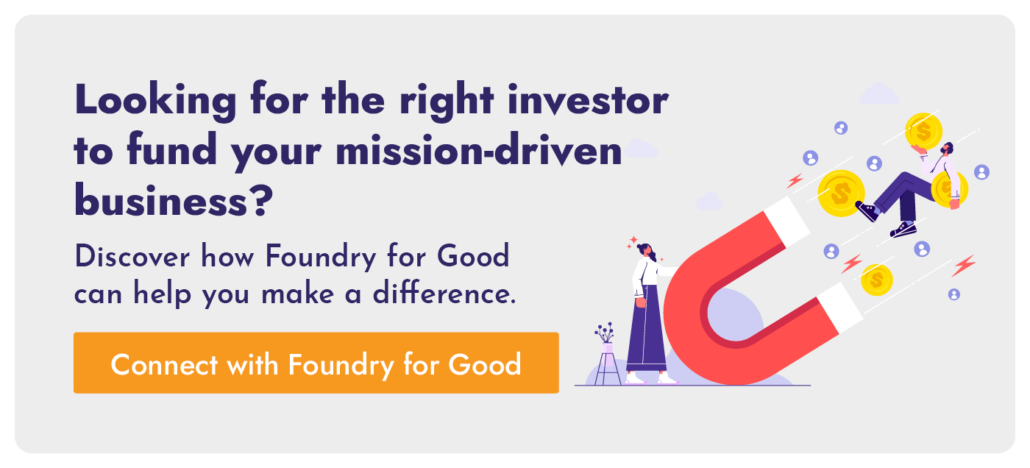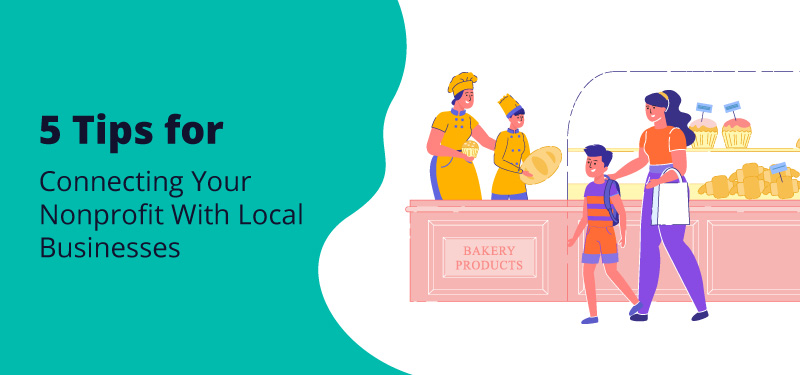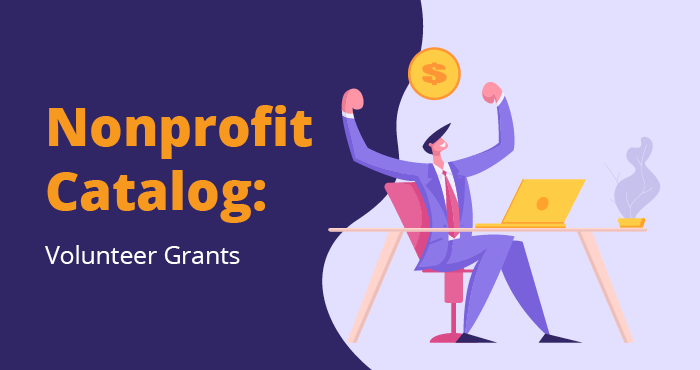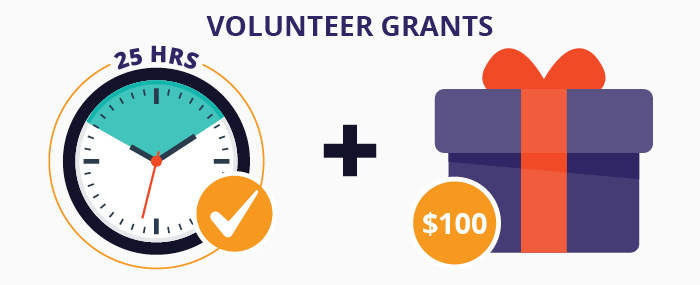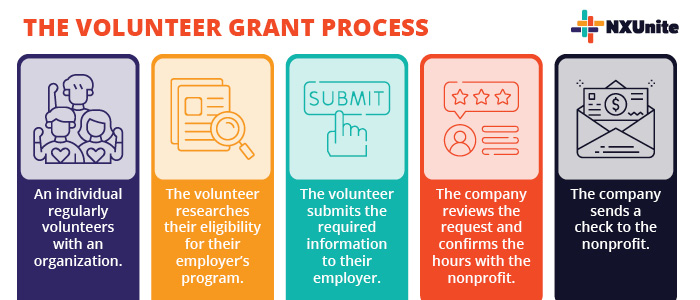A Spotlight on 10 Top Impact Investors Driving Social Change
Starting a business that’s focused on social good is noble, but like almost all businesses, it requires financial support to flourish. Fortunately, there’s a growing group of investors who are passionate about more than just making money—they want to make a difference.
In a world where profit meets purpose, impact investors are reshaping the business landscape by investing capital into startups and small companies dedicated to making a positive difference.
If you’re a founder of a social good startup looking for investors who share your values, you’re in the right spot. In this article, we’ll introduce you to remarkable social good investors who are actively seeking out companies committed to positive change, including anything from fundraising technology vendors to Google Grants agencies. Here’s what we’ll cover:
- Understanding Impact Investing
- Our Recommended Impact Investor: Foundry for Good
- Other Social Good Investors Making A Difference
If you’re a founder with a vision, these investors could be your key to success. As a company that’s powered by mission-driven investors, our team at NXUnite is excited to share our unique perspective and help you understand the role these groups are making.

Understanding Impact Investing
Before shining the spotlight on specific investors, let’s take a step back and start with the fundamentals of impact investing. We’ll walk through basic questions, so you can make an informed decision when choosing an investor for your business.
What is impact investing?
Impact investing is when a business or other entity invests in companies or organizations with the dual aim of achieving financial returns and positive impacts. Unlike traditional investments that focus primarily on financial gains, impact investing strongly emphasizes achieving measurable outcomes in social good areas like environmental sustainability, education, poverty, social justice, and healthcare.
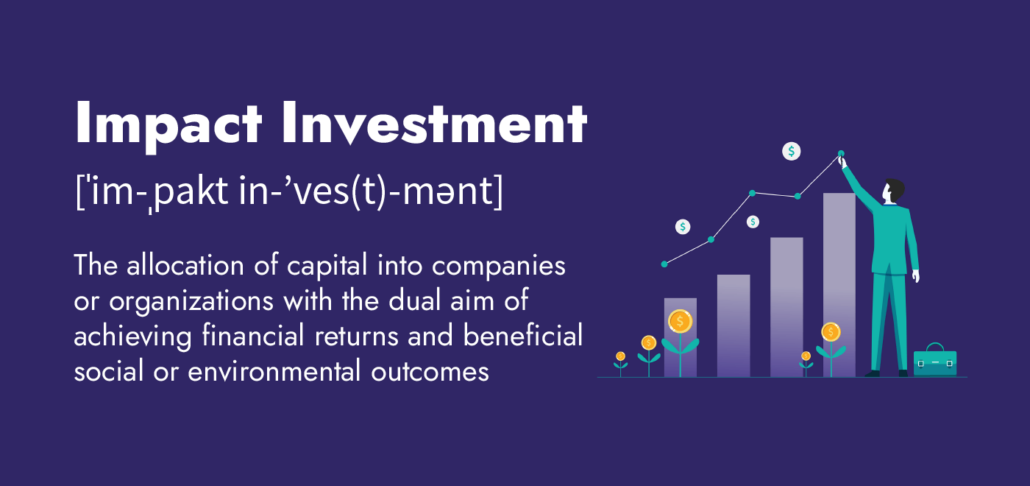
Key aspects of impact investing include:
- Value Alignment: Social good investors seek investments that align with their values and social or environmental goals.
- Measurable Impact: These investments are intended to produce quantifiable and positive societal or environmental outcomes. As such, investors use various metrics to assess their investments’ impact.
- Financial Returns: While intended to create positive change, impact investing should still be financially viable and competitive with traditional investments.
- Diverse Focus Areas: Impact investments cover a range of sectors, such as renewable energy, education, and affordable housing.
While these investments involve several moving parts, impact investing is essentially leveraging capital to create positive change, earn revenue, and drive innovation across the social good sector.
Does impact investing make a difference?
Yes, it does! Impact investing has gained momentum as individuals and businesses increasingly recognize their ability to address pressing global challenges while also earning financial benefits.
By directing capital into businesses and initiatives that aim to drive change, impact investing provides these benefits:
- Scaling Social Innovation: Impact investing funds innovative and socially responsible startups and small businesses. This financial support helps recipients expand operations, reach more people, and accelerate impact.
- Attracting More Capital: The success of impact investments can inspire other investors to allocate their capital toward socially and environmentally responsible initiatives. In other words, they create a snowball effect of positive change.
- Aligning Values and Finance: Impact investing allows businesses to align their financial resources with their values and missions, ensuring their investments have a meaningful impact on the world.
Overall, impact investing enables investors to use their financial resources strategically to drive positive change, solve global challenges, and promote a more sustainable and equitable future. It demonstrates that financial returns and ESG impact can be mutually reinforcing.
How do I find social impact investors?
Browsing lists like this one is a good start. Consider following industry blogs or using online investment platforms like Toniic and the Global Impact Investing Network (GIIN) Investor Directory. These platforms connect social impact entrepreneurs with potential investors.
You can also join impact investing conferences and networking events. These gatherings attract social impact investors, foundations, and philanthropic organizations. Attend these events and start conversations with potential funders for your business.
What’s the difference between impact investing and ESG investing?
While similar, these two types of investments have a key difference.
Impact investors focus on generating specific, measurable, and positive social or environmental impacts alongside financial returns. Meanwhile, environmental, social, or governance (ESG) investors incorporate ESG factors into the investment decision-making process.
ESG investors look for companies that meet specific ESG requirements, but the companies they invest in aren’t necessarily part of the social good sector. For example, an investor might use ESG standards to assess a for-profit clothing store’s supply chain practices. By integrating these non-financial factors into their investment strategies, they aim to mitigate risks and ensure they support businesses that will be sustainable long-term.
Our Recommended Impact Investor: Foundry for Good
Focus Area: Mission-Driven Businesses Such As Nonprofit Technology and Consulting Services
With a diverse background of investments, Foundry For Good knows how to take your social impact further. They won’t just invest capital; they’ll infuse your mission-driven startup with strategic marketing solutions.
Foundry for Good provides you with direct access to experts in philanthropy and change, like the changemakers here at NXUnite!
Here are their primary areas of focus:
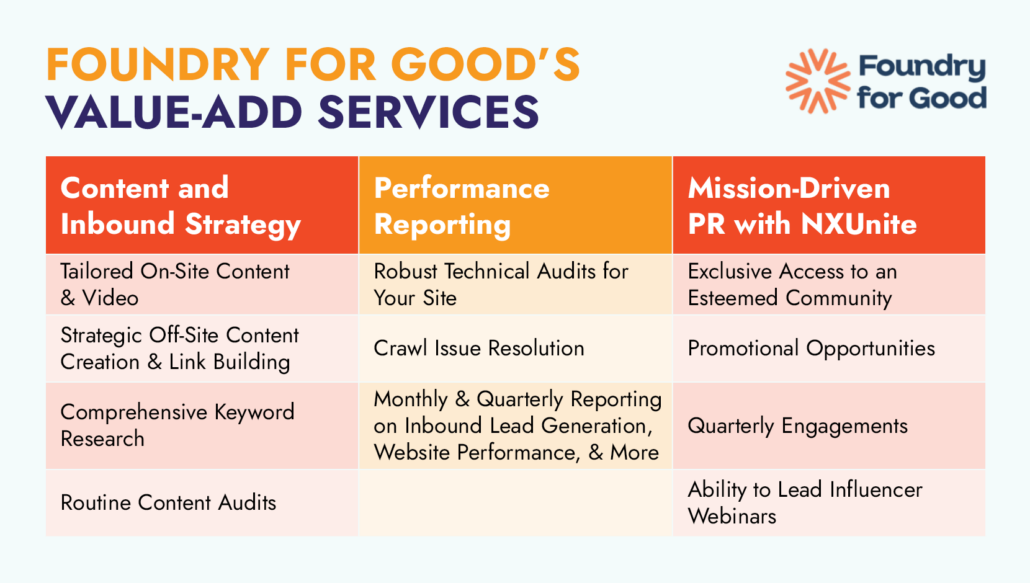
- Content and Inbound Strategy: They’ll create content tailored to your brand, increase brand visibility with content on influential websites, help you stay ahead in search engine traffic via keyword research, and regularly audit your content. Essentially, they’ll elevate your content strategy both on and offsite.
- Performance Reporting: Foundry for Good will conduct robust technical audits and rectify high-priority SEO issues to give your site the strongest foundation possible to attract potential customers. With detailed reports, they’ll keep you in the loop on inbound lead generation, keyword performance, and technical performance.
- Mission-Driven PR with NXUnite: Join our community of like-minded businesses, leverage sponsored emails, be a part of panels, and lead exclusive webinars to generate leads and grow your business.
Backed by a passionate team, a network of mission-driven businesses, and cutting-edge marketing strategies, Foundry for Good will make sure your business’s impact is felt.
Notable Impact Investments
Foundry for Good has an evergrowing portfolio of social good investments. Some of their companies making a difference include:

- NXUnite by Nexus Marketing offers our vibrant online community that brings brands and mission-driven professionals together through webinars, online directories, and educational content. It’s a place where we showcase our friends in the industry, help them forge new connections, and foster unity across the mission-driven sector.
- Double the Donation is the leading provider of matching gift software to nonprofits and educational institutions. It provides access to the world’s most robust database of corporate matching gift program records, covering over 99% of match-eligible donors.
- Nexus Marketing is the only digital marketing agency specializing in social good professionals and how they find the products, people, and services they need. We offer SEO and content marketing services for brands powering community impact.
- eCardWidget provides adaptable eCard software, ideal for everything from nonprofits thanking donors to businesses inspiring employees. Thanks to its customizability, eCardWidget empowers users to create custom eCards branded to their cause or business within seconds.
- Getting Attention provides Google Ad Grant services to nonprofits. Their global team helps nonprofits through every stage of the grant management process, including everything from applying for the grant to creating ads and maintaining eligibility. With their expert help, Getting Attention clients can make the most of their $10,000 in ad credits each month.
If you’re looking for a reliable impact investor, we can’t sing Foundry for Good’s praises enough! Chat with their team to see if they’re the right fit for your business.

Other Social Good Investors Making A Difference
We’ve used a variety of methods to evaluate these remaining investors, such as selecting ones with substantial assets under management (AUM), which is the total market value of investments they manage.
Whether you’re looking for nonprofit technology investors, consulting agency investors, or mission-driven investors in general, there’s something for every small business wanting to power their social impact initiative.
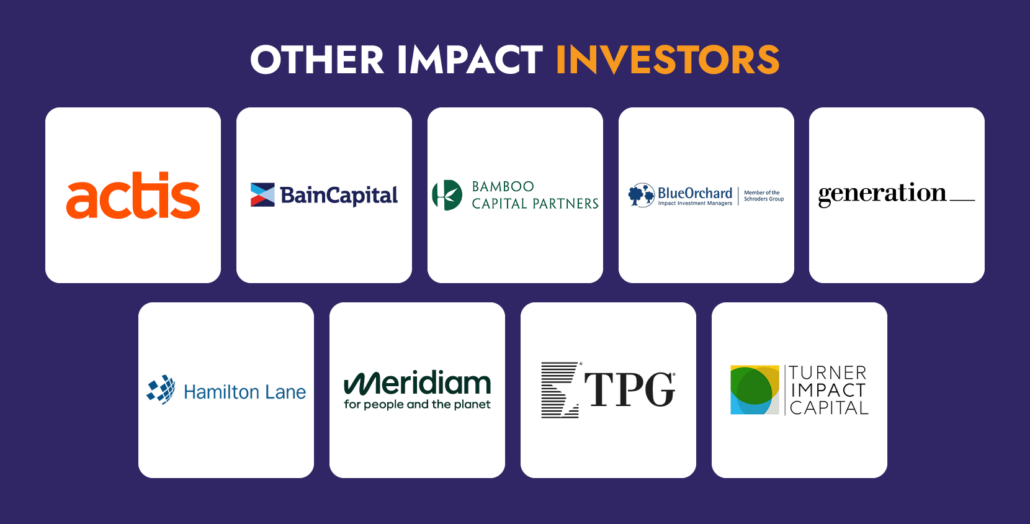
Actis
Focus Area: Sustainable Infrastructure
Actis is a leading global investor in sustainable infrastructure. Since its inception in 2004, this impact investor has raised $24 billion to invest in a better tomorrow. They invest in energy infrastructure, long life infrastructure, digital infrastructure, real estate, and private equity.
Actis has a long history of building businesses. Today, it has 17 offices across the globe, enabling them to invest in meaningful opportunities wherever they may come from. They have an impressive portfolio of organizations they’ve invested in, including energy infrastructure companies like Atlas Renewable Energy, long life infrastructure companies like Emicool, and private equity firms like Upstream Systems.
Bain Capital
Focus Areas: Health and Wellness, Education and Workforce Development, and Sustainability
Established in 1984, Bain Capital is a private investment firm with approximately $180 billion in AUM.
While known for its traditional investment activities, Bain Capital has an impact investing arm called Bain Capital Double Impact. With this division of their firm, they invest in companies and initiatives that address social and environmental challenges, such as healthcare, education, sustainability, and social equality.
One example of their work is their recent partnership with Meteor Education. With Bain Capital’s support, they aim to expand Meteor Education into new markets and advance its mission to support educators in creating enriching learning experiences.
Bamboo Capital Partners
Focus Areas: Financial Inclusion, Access to Clean Energy, Access to Healthcare, and Agribusiness
Founded in 2007, Bamboo Capital Partners has a global presence in impact investing markets. Bamboo aims to improve the lives of marginalized communities while delivering financial returns. It employs a blended finance approach and works with partners (such as foundations and other impact investors) to jumpstart opportunities brought to them.
Bamboo specifically targets companies with products, services, or operations that lead to positive social and/or environmental changes. For example, that might mean a business that improves the quality of life or one that increases efficiencies to reduce expenses for target populations.
BlueOrchard Finance S.A.
Focus Areas: Financial Inclusion and Poverty Alleviation
With principal offices in Switzerland, BlueOrchard Financial operates in more than 100 emerging and frontier markets in various areas like Asia, Latin America, Africa, and Eastern Europe. It was founded as part of a United Nations initiative in 2001 as the first commercial manager of microfinance debt investment worldwide. That makes it an impact investment pioneer.
Now, BlueOrchard is majority-owned by asset management business, Schroders, and has a global reach of more than 280 million people. Schroders targets sophisticated investors and global initiatives that fight inequality and the effects of climate change. They have a presence in the microfinance, agriculture, renewable energy, healthcare, and education sectors.
One of BlueOrchard’s recent investments is ChargeZone, a fast-growing electric vehicle charging company located in India. BlueOrchard invested in the company to fund the roll-out of 286 charging stations, serving 1,130 electric buses.
Generation Investment Management
Focus Areas: Global Equity, Asia Equity, Growth Equity, and Private Equity
Founded by Al Gore and David Blood in 2004, Generation Investment Management has pioneered the development of sustainability and ESG investing. Known for its commitment to impact investing, this firm strives to deliver long-term financial returns while addressing global sustainability challenges like environmental degradation.
It employs a sustainable capitalistic approach, emphasizing that “sustainability factors have a material impact on companies’ returns over the long term.”
Hamilton Lane
Focus Areas: Professional Services, Renewable Energy, and Software
With 22 years of impact investing experience, Hamilton Lane is a leading, global investment manager providing private markets solutions. Since 2001, they’ve invested in mission-driven solutions and now have $3.1 billion in assets related to impact strategies. What’s more, they report on the impact of their investments to ensure they help companies drive social change. Examples of metrics include energy savings, water cleaned, and reduction in CO2 emissions.
In March 2022, Hamilton Lane released a Climate Policy Statement to communicate its dedication to the global search for climate-change solutions. They also pledged to reach net-zero emissions by 2050.
Some of Hamilton Lane’s investments include:
- Intersect Power, which develops large utility-scale renewable energy with a focus on solar and battery-storage projects.
- TXO Systems, which provides B2B circular economy solutions for telecommunications and related industries through selling, reusing, repairing, and recycling equipment.
- Neuroflow, which provides behavioral health software that uses digital features to reinforce in-person clinical care.
Meridiam Infrastructure
Focus Areas: Critical Public Services, Sustainable Mobility, and Innovative Low Carbon Solutions
Meridiam Infrastructure is driven by its mission to make the UN Sustainable Development Goals a reality. They translated these goals into their organization’s five strategic pillars:
- Deliver resilient infrastructure and develop resilient cities.
- Accelerate energy transition.
- Avoid & reduce emissions.
- Promote good work conditions, inclusion, diversity & gender equality.
- Protect & enhance biodiversity.
Driven by these pillars, they strive to build resilient communities, tackle climate change, and protect the environment. They do so by supporting and accelerating the development of innovative, ambitious SMEs leading the ecological transition.
Meridiam Infrastructure currently manages more than 120 assets in the social good sector around the world. One investment example is Okamac, which is the European leader of Apple computer reconditioning. Meridiam Infrastructure invested in Okamac to participate in the decarbonization of the computing sector by supporting a global champion of computer reconditioning.
TPG
Focus Areas: Climate and Conservation, Education, Financial Inclusion, Food and Agriculture, Healthcare, and Impact Services
Launched in 1992, TPG is now a leading global alternative asset manager. They launched The Rise Fund in 2016, making them the first global alternative asset manager to develop an impact investing business with more than $1 billion in AUM. Today, they have more than $18 billion in AUM.
They believe that private enterprise is critical in addressing global societal changes, and their Impact platform helps drive competitive financial returns and measurable societal benefits. Here’s an overview of their investment funds:
- The Rise Fund offers investment resources, business-building skills, and a global network to grow profitable businesses seeking to deliver positive and sustainable impact.
- TPG Rise Climate is their dedicated climate impact investing product. This fund was created to address global climate change challenges and scale innovative businesses that can enable quantifiable carbon aversion.
- Evercare is a healthcare fund that strives to provide affordable, high-quality healthcare.
Ideal for companies looking for a vast network, TPG has a substantial global network for raising capital and driving value in their investments. Some of their investments include Palmetto, which expands access to clean energy for homeowners and businesses, and Teachers of Tomorrow, which focuses on creating education leaders.
Turner Impact Capital
Focus Areas: Educational Facilities, Affordable Housing, and Healthcare Facilities
As one of the fastest-growing social impact investors, Turner Impact Capital specializes in investing in and developing real estate projects that positively influence society and generate financial returns. They work to address critical societal challenges, particularly in underserved communities, to help create positive change in communities where their investments can make a measurable difference.
For example, they invest in the development and improvement of affordable workforce housing and community healthcare centers in low-income areas.
Final Thoughts on These Social Good Investors
Impact investing isn’t just about dollars and cents; it’s about making a meaningful impact. Impact investing bridges the gap between profit-driven business and social good. For founders of startups and small social good companies, the right investor can be a game-changer.
Again, we recommend chatting with Foundry for Good, a social good investor who’s actively investing in businesses that cater to nonprofits.
As you continue along in your journey, explore these additional resources:
- Why Companies Should Have Employee Giving Programs: You want your business’ impact to be felt, and a great way to accomplish that is through employee giving. Discover the power of these programs and how to establish workplace giving program.
- Corporate Philanthropy – Nonprofit Catalog: Learn the fundamentals of corporate philanthropy and how it helps nonprofits and socially-responsible companies alike.
- How to Develop a Corporate Charitable Giving Policy: A Guide: Explore this guide to learn how to put giving back to society at the forefront of your business’s mission.
